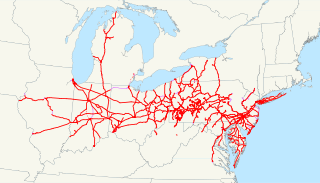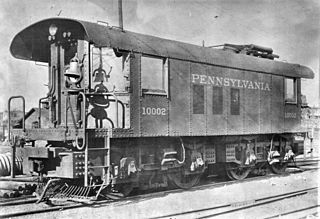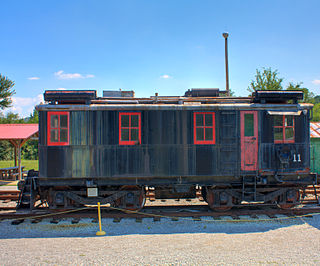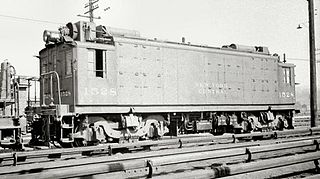
The Pennsylvania Railroad was an American Class I railroad that was established in 1846 and was headquartered in Philadelphia, Pennsylvania. It was so named because it was established in the Commonwealth of Pennsylvania.

The American Locomotive Company was an American manufacturer of locomotives, diesel generators, steel, and tanks that operated from 1901 to 1969.

A diesel locomotive is a type of railway locomotive in which the prime mover is a diesel engine. Several types of diesel locomotives have been developed, differing mainly in the means by which mechanical power is conveyed to the driving wheels.

An electric locomotive is a locomotive powered by electricity from overhead lines, a third rail or on-board energy storage such as a battery or a supercapacitor.
The AAR wheel arrangement system is a method of classifying locomotive wheel arrangements that was developed by the Association of American Railroads. It is essentially a simplification of the European UIC classification, and it is widely used in North America to describe diesel and electric locomotives. It is not used for steam locomotives which use the Whyte notation instead.

An electro-diesel locomotive is a type of locomotive that can be powered either from an electricity supply or by using the onboard diesel engine. For the most part, these locomotives are built to serve regional, niche markets with a very specific purpose.

A boxcab, in railroad terminology, is a locomotive in which the machinery and crew areas are enclosed in a box-like superstructure. It is a term mostly used in North America while in Victoria (Australia), such locomotives have been nicknamed "butterboxes". Boxcabs may use any source of power but most are diesel or electric locomotives. Few steam locomotives are so described but the British SR Leader class was a possible exception. Most American boxcabs date from before World War II, when the earliest boxcabs were often termed "oil-electrics" to avoid the use of the German name "Diesel" due to propaganda purposes.
The Pennsylvania Railroad's class P5 comprised 92 mixed-traffic electric locomotives constructed 1931–1935 by the PRR, Westinghouse and General Electric. Although the original intention was that they work many passenger trains, the success of the GG1 locomotives meant that the P5 class were mostly used on freight. A single survivor, prototype #4700, is at the Museum of Transportation in St Louis, Missouri.

The Pennsylvania Railroad's class DD2 electric locomotive was a single prototype locomotive never placed into series production. It was intended as an improved and simplified GG1 for use on the planned, but never built, extension of the PRR's electrification west of Harrisburg, Pennsylvania. The one locomotive produced was numbered #5800 and used in regular Baltimore tunnel helper service until it was scrapped in September 1962.

The Pennsylvania Railroad's class AA1 comprised two experimental electric locomotives constructed in 1905 by the company's own Altoona Works with the assistance of Westinghouse. Intended as testbeds as the PRR began its electrification project, both locomotives remained service into the 1930s.

In railroad terminology, a steeplecab is a style or design of electric locomotive; the term is rarely if ever used for other forms of power. The name originated in North America and has been used in Britain as well.

The ALCO boxcabs were diesel-electric switcher locomotives, otherwise known as AGEIR boxcabs as a contraction of the names of the builders. Produced by a partnership of three companies, ALCO built the chassis and running gear, General Electric the generator, motors and controls, and Ingersoll Rand the diesel engine. The principle of operation was the same as modern locomotives, the diesel engine driving a main generator of 600 volts DC with four traction motors, one per axle.

T-Motor was the class designation given by the New York Central to its ALCO-GE built T-1a, T-1b, T-2a, T-2b, and T-3a electric locomotives. The T-Motors were the New York Central's second electric locomotive purchase after the original class of S-Motors. The T-motors continued on in service with the New York Central and a few continued on with the Penn Central after the 1968 merger.

The GE boxcabs, sometimes also GE IR boxcabs, were diesel-electric switcher locomotives succeeding the ALCO boxcabs. The locomotives were built by General Electric and Ingersoll Rand without ALCO. Production lasted from 1928 till 1930. These boxcabs were often termed oil-electrics to avoid the use of the German name Diesel, unpopular after World War I.

The GE three-power boxcabs were early electro-diesel hybrid switcher locomotives. These boxcabs were termed oil battery electrics to avoid the use of the German name Diesel, unpopular after World War I.

S-Motor was the class designation given by the New York Central to its ALCO-GE built S-1, S-2, S-2a and S-3 electric locomotives. The S-Motors hold the distinction of being the world's first mass-produced main line electric locomotives with the prototype #6000 being constructed in 1904. The S-Motors would serve alone until the more powerful T-motors began to arrive in 1913, eventually displacing them from main line passenger duties. From that point the class was assigned to shorter commuter trains and deadhead rolling stock between Grand Central Terminal and Mott Haven coach yard. Some examples, including the prototype later renumbered #100, would serve in this capacity through the Penn Central merger in 1968, only being retired in the 1970s as long distance passenger traffic to Grand Central dried up.

P-Motor was the class designation given by the New York Central a fleet of 22 ALCO-GE electric passenger locomotives. The P Motors were not only more powerful than previous New York Central electric, but also a more advanced design using the highly successful 2-C+C-2 wheel arrangement found on the later PRR GG1 and New Haven EP-3 classes as well as nose suspended traction motors. Although originally built and owned by a consortium of railroads involved in the large scale Cleveland Union Terminal project, the New York Central was the majority owner and later acquired them outright in the 1950s when the Terminal's electrification scheme was scrapped in favor of diesels. Rebuilt and re-classified as P-2, the 21 remaining engines were sent to the New York electrified zone to supplement the aging fleet of T-Motors that had been purchased starting in 1913. There they played out the remainder of their careers pulling the Central's premier passenger trains.

The GN boxcab locomotives were the first electric locomotives purchased by the Great Northern Railway (GN) for use through the Cascade Tunnel. Four locomotives were supplied by the American Locomotive Company; they used electrical equipment from General Electric and weighed 115 short tons (104 t) each.

The Great Northern Z-1 was a class of ten electric locomotives built for the Great Northern Railway They were used to work the route through the second Cascade Tunnel. They were built between 1926–1928 by Baldwin Locomotive Works, with Westinghouse electrics, and stayed in service until dieselisation in 1956. Each was of 1,830 horsepower (1,360 kW) with a 1-D-1 wheel arrangement, although they were always used in coupled pairs.

















